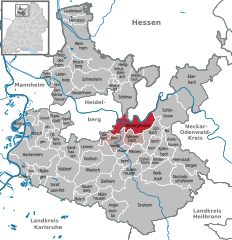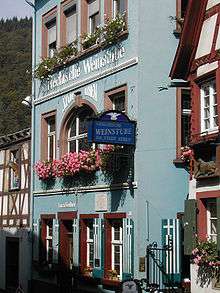Neckargemünd
| Neckargemünd | ||
|---|---|---|
|
View of the town | ||
| ||
 Neckargemünd | ||
Location of Neckargemünd within Rhein-Neckar-Kreis district 
 | ||
| Coordinates: 49°23′38″N 08°47′51″E / 49.39389°N 8.79750°ECoordinates: 49°23′38″N 08°47′51″E / 49.39389°N 8.79750°E | ||
| Country | Germany | |
| State | Baden-Württemberg | |
| Admin. region | Karlsruhe | |
| District | Rhein-Neckar-Kreis | |
| Government | ||
| • Mayor | Horst Althoff | |
| Area | ||
| • Total | 26.15 km2 (10.10 sq mi) | |
| Population (2015-12-31)[1] | ||
| • Total | 13,369 | |
| • Density | 510/km2 (1,300/sq mi) | |
| Time zone | CET/CEST (UTC+1/+2) | |
| Postal codes | 69151 | |
| Dialling codes | 06223 | |
| Vehicle registration | HD | |
| Website | www.neckargemuend.de | |
Neckargemünd is a town in Germany, in the district of Rhein-Neckar-Kreis, state of Baden-Württemberg. It lies on the Neckar, 10 km upriver from Heidelberg at the confluence with the river Elsenz.[2] This confluence of the two rivers is the origin of the name, as Neckargemünd means confluence of the Neckar. As of 2006, there were 14,122 inhabitants.
History
The region has been occupied by people for a half a million years as shown by the find of Homo heidelbergensis in nearby Mauer in 1907. Stone shards and stone axes have been found from the Early Stone Age. During Roman times the area was settled by Celts and Suebi. Grave stones from the 2nd and 3rd century in Kleingemünd show Celtic names. From the end of the 5th century the Franks held sway over the region. An iron spear tip and two iron arrow heads were left behind in Neckargemünd.[2]
Neckargemünd was founded in the 10th century, most likely as a fishing village. Neckargemünd was first mentioned by name in documents in 988. Otto III, Holy Roman Emperor enfeoffed Hildebald, Bishop of Worms, with the royal forests around Wimpfen and Neckarbischofsheim. Neckargemünd was named as the northwest corner of this area: a loco Gemundi ubi Elisinzia fluvius influit Neccaro fluvio. The counts of Lauffen also played a role in the region after making Dilsberg the seat of their domain.[2] Neckargemünd became a free town in 1286. In 1395 it passed to the elector palatine and, together with the surrounding district, became part of Baden in 1814.
Boroughs
Neckargemünd includes a number of boroughs (Ortsteile) not part of the core settlement Neckargemünd. These are Kleingemünd (independent from Neckargemünd only from 1860-1906), Dilsberg including Neuhof, Dilsbergerhof, and Rainbach (since 1973), Waldhilsbach (since 1974), and Mückenloch (since 1975). Dilsberg hosts Bergfeste Dilsberg.[2]
International relations

Neckargemünd is twinned with the following cities:[3]
 Evian-les-Bains, France, since 1970
Evian-les-Bains, France, since 1970 Valeč, Czech Republic, since 1965
Valeč, Czech Republic, since 1965 Missoula, Montana United States, since 1993
Missoula, Montana United States, since 1993 Jindřichův Hradec, Czech Republic, since 1996
Jindřichův Hradec, Czech Republic, since 1996 Romeno, Italy, since 1996
Romeno, Italy, since 1996
References
- ↑ "Gemeinden in Deutschland nach Fläche, Bevölkerung und Postleitzahl am 30.09.2016". Statistisches Bundesamt (in German). 2016.
- 1 2 3 4 "Stadtgeschichte Neckargemünd" (in German). Neckargemünd. Retrieved 2 August 2010.
- ↑ "Partnerstlädte und Verbindungen" (in German). Neckargemünd. Retrieved 3 August 2010.
![]() This article incorporates text from a publication now in the public domain: Chisholm, Hugh, ed. (1911). "article name needed". Encyclopædia Britannica (11th ed.). Cambridge University Press.
This article incorporates text from a publication now in the public domain: Chisholm, Hugh, ed. (1911). "article name needed". Encyclopædia Britannica (11th ed.). Cambridge University Press.

